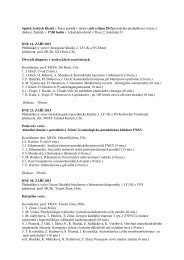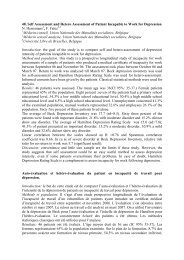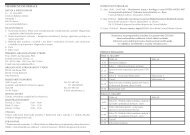ABSTRACTS â ORAL PRESENTATIONS - AMCA, spol. s r.o.
ABSTRACTS â ORAL PRESENTATIONS - AMCA, spol. s r.o.
ABSTRACTS â ORAL PRESENTATIONS - AMCA, spol. s r.o.
You also want an ePaper? Increase the reach of your titles
YUMPU automatically turns print PDFs into web optimized ePapers that Google loves.
36. B-CELL IMMUNOPHENOTYPING OF LARGE GROUP OF COMMON VARIABLE<br />
IMMUNODEFICIENCY PATIENTS REVEALED SUBCLUSTER WITH DISTINCT CLINICAL<br />
FEATURES AND SIMILAR T-CELL, CYTOKINE AND GENOMIC ABNORMALITIES<br />
Veronika Kanderova 1 , Jan Stuchly 1 , Marcela Vlkova 2 , Ivana Hermanova 1 , Ladislav Krol 1 ,<br />
Marie Trkova 4 , Ondrej Hrusak 1 , Anna Sediva 3 , Jiri Litzman 2 , Eva Fronkova 1 , Tomas Kalina 1<br />
1<br />
Charles University, 2 nd Faculty of Medicine, Dpt. of Pediatric Hematology / Oncology,<br />
CLIP-Cytometry, Prague, Czech Republic, veronika.kanderova@lfmotol.cuni.cz<br />
2<br />
Department of Clinical Immunology and Allergology, St Anne’s University Hospital and<br />
Faculty of Medicine, Masaryk University, Brno, Czech Republic<br />
3<br />
Charles University, 2 nd Faculty of Medicine, Dpt. of Immunology, Prague, Czech Republic<br />
4<br />
Gennet, Genetics and Reproduction Medicine Center, Prague, Czech Republic<br />
Common Variable Immunodeficiency (CVID) is a heterogeneous disorder of unknown<br />
etiology. The hallmark of the disease is a humoral deficiency characterized by low<br />
levels of serum IgG, IgA, and/or IgM, impaired specific antibody response after antigen<br />
challenge and the resulting bacterial infections. Investigation of peripheral blood<br />
cellular compartments revealed abnormalities in B- and T-cells. Due to a high number of<br />
analysed parameters it is difficult to define CVID subgroups that possibly share the same<br />
pathological mechanisms.<br />
We have investigated detailed immunophenotype of B-cells and T-cells in CVID patients<br />
by 8 color flow cytometry. We have used previously reported unsupervised method of<br />
probability binning to compare distribution of cells within all possible phenotypes. Ninetyeight<br />
patients‘ and 47 healthy donors‘ samples were used to create hierarchical tree<br />
according to B-cell immunophenotype similarities. The cohort split into 11 phenotype<br />
clusters and additional one with missing B-cells. Only one B-cell cluster (further<br />
referenced as cluster_5) presented with characteristically aberrant immunophenotype<br />
of T-cells. Cluster_5 CD4+ T-cells were reduced and presented with decreased proportion<br />
of naive cells and increased proportion of intermediate effector memory cells (CD27-<br />
CD28+). Increased expression of marker of exhaustion CD57, marker of anergy PD-1<br />
and activation markers CD69 and CD70 suggested a chronic activation but activating<br />
plasma cytokine levels (e.g. IFNg, IL-2, IL-4, IL-5 measured by bead assay) were not<br />
elevated. Moreover, cluster_5 B-cells contained increased numbers of CD27-CD21- cells,<br />
low number of follicular FO II cells and reduced transitional cells as compared to other<br />
clusters.<br />
Similar clinical presentation (autoimmunity and splenomegaly) and phenotypic profile<br />
supported the idea of similar pathological mechanism. Whole-exome sequencing<br />
yielded 23 possibly damaging gene alterations (single-nucleotide polymorphisms, SNP)<br />
present in cluster_5 patients but not in controls. Minor allele variant of SNPs rs17615<br />
and rs1048971 in CR2 (CD21) gene causing alternative splicing of exon 11 was present in<br />
all investigated cluster_5 patients (n=6) although the frequency of minor allele in healthy<br />
population is 27% (p








